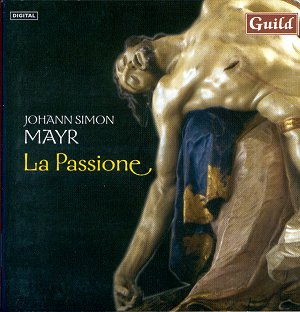If Johann Simon Mayr (or Giovanni Simone Mayr, as he
became known in Italy) is known at all today, it is as the teacher of
Donizetti. One or two of his operas, such as 'Medea in Corinto' have
become a little better known thanks to their CD recordings. It might
come as a surprise to find that Mayr wrote a considerable quantity of
liturgical music. He was a devout Catholic and founded a music school
which was closely linked to the Basilica of S. Maria Maggiore in Bergamo.
He composed sacred music for all occasions and was still composing it
in the year of his death.
1794, the year of composition of 'La Passione',
also saw the first performance of Mayr's opera 'Saffo'. This was a great
success, allowing the composer to develop his voice in Italian opera.
'La Passione' is one of a group of early oratorios, written whilst Mayr
was associated with the Ospedali dei Mendicanti, one of the four music
conservatories in Venice concerned with orphans. Though he wrote oratorios
for the Ospedali, 'La Passione' was written for another church, so Mayr
was not limited to girls voices and could introduce greater dramatic
scope. The text, by an unknown author, draws on Metastasio's 'Passione'
and is typical of the oratorios produced by the counter-reformation,
consisting of a series of meditations on the sacred events, centred
on the Virginís response to her Sonís sufferings and her consequent
agony as a mother.
'La Passione' is in two parts. Part 1, on the way to
Calvary, opens with a sinfonia followed by the opening chorus. From
then on Mayr dramatises the text via a sequence of recitatives (mainly
accompanied) and arias. Part 2, at the foot of the Cross, follows a
similar pattern and finishes with a final chorus. The key word here
is dramatises. This is a dramatic, almost operatic work. Not for Mayr
the quiet contemplation of the more Germanic oratorios. The opening
sinfonia is surprisingly cheerful and would not come amiss as the overture
to an opera buffo; evidently this is meant to suggest Victory over Death.
The following chorus is also very operatic, intermingling chorus with
solo interjections. Mayr's style hovers between the world familiar to
Mozart and Haydn and the style that was to become the early 19th
Century Italian opera.
The soprano Maria Jette sings the role of Mary the
Mother of Christ, around whom the action centres. Contralto Claudia
Schneider sings Mary Magdalene, tenor Hartmut Schröder sings St.
John and bass-baritone Robert Merwald sings Joseph of Arimathea. Neither
Christ nor Evangelist appear at all, though Christ's words from the
cross are reported in the recitative. The narrative moves along with
a series of accompanied recitatives for each of the characters. These
contain some of the most dramatic moments in the work and I felt that
the performers did not nearly make enough of them. St. John's recitative
at the end of part one 'Why does not my heart break at the sight of
such barbaric cruelty? Who has witnessed such a frightful spectacle?'
is finely played and sung but lacks the dramatic impetus needed by the
words. This is not meditatively deep music, Mayr gives the text impetus
by dramatising it and using word painting. Too frequently the performers
seem to give it too little light and shade, content to skim over the
surface of this attractive work.
And attractive it is too. Mayr had significant melodic
gifts and all the soloists perform their arias attractively and finely.
Maria Jette sings affectingly, displaying a fine upper register but
she tends to be rhythmically four-square, I could have wished for greater
flexibility from her. Claudia Schneider has an attractive deep toned
voice, not without a hint of unsteadiness and at times she seemed uncomfortable
with the fioriture. Hartmut Schröder's tenor is an attractive instrument
but his bright tone tends to be unvarying and can be a little wearying.
In Part 2, the drama intensifies and the soloists respond to this, except
for Hartmut Schröder who seems to value beauty of line more than
the drama implicit in the words.
The orchestra, Georgisches Kammerorchester Ingolstadt,
under Franz Hauk play the music capably if without much subtlety and
Hauk's speeds tend to be on the safe side. He seems to mistake slowness
for emotion, Maria's cavatina 'Fra líorror deímalií seems in danger
of grinding to a halt. I would love to hear this music in a more responsive
performance played on original instruments. Luckily there is not too
much secco recitative as the harpsichord used on the recording has a
distinctly clangy tone.
The second work is a Stabat Mater. An
apt companion as the texts of the two works are both quite similar in
tone. The Stabat Mater is labelled no. 5 but there is no trace of any
of the 4 preceding works (if they existed at all). It is a charming
work and has the advantage that there are no passages of recitative,
simply a sequence of arias and ensembles. Music in an over-wrought style
to match the words is not for Mayr, he writes with almost classical
poise. Though the work opens and closes with substantial four-part ensembles,
these are performed here by the soloists alone with no choral contribution,
evidently Mayr performed the work in this form as well as performing
it with a chorus. Having the chorus parts sung by soloists has the advantage
of making the piece sound more homogeneous but the final chorus does
rather cry out for a real choral sound. In the chorus numbers the soloists
blend beautifully, creating a really effective ensemble.
Guild are to be congratulated on issuing these recordings
of Mayr's sacred music. The performances by the Ingolstadt forces are
quite creditable and make a good introduction to Mayr's music of this
period. Perhaps one of our period instrument groups will now take up
the challenge and give us some more.
Robert Hugill
